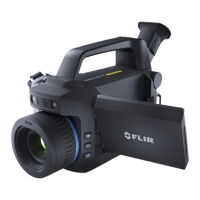Quantification
9
9.4.4 Camera temperature range
For each background, you should check to see that the camera is operating in the proper
temperature range. The camera will provide the upper and lower temperatures for each
range and a visual indicator to show the distribution of the pixels in the image. If a major-
ity of the pixels are near the top or the bottom of the temperature range, the operator
should adjust the temperature range to obtain accurate quantification results. A common
scenario where this becomes necessary occurs when the sky is used as a background.
The sky typically has very little radiance in the mid-wave infrared. As a result, the appa-
rent temperature of the sky can be quite low. It is often necessary to lower the tempera-
ture range of the camera when switching to a sky background.
9.4.5 Field of view and focus
A critical component of the leak rate measurement process is adjusting the field of view
(FOV) for the camera. The camera should be positioned so that the leak location is in the
center of the FOV. You should verify that the gas leak is in the center of the measurement
boundary (i.e. the ring) and that the gas plume is flowing across the measurement boun-
dary. In general, the best quantification results will be obtained if the leak originates in
the center of the FOV with a clear field of view as the plume passes across the measure-
ment boundary roughly perpendicular to the camera FOV.
In some cases, it is easy and obvious to determine the location of the leak. These leaks
are emanating from a single location and the plume emanates from that single location.
In other cases, the leak is emanating from a component such as a flange or valve without
a clearly defined source. In these cases, centering the component in the FOV is
sufficient.
The focus of the camera can potentially affect the measurement. The user should take
care to ensure that both the leak site (leaking component or plume) as well as the back-
ground are in focus. This may or may not be feasible depending on the camera lens used
(which determines the depth of field), the distance between the leak site and the back-
ground objects, and the distance to the camera. When it is not feasible to bring both the
plume and the background into focus, priority should be given to the plume.
9.4.6 Leak rate versus concentration
The camera allows you to measure both flow rate and concentration.
9.4.6.1 Flow rate
When measuring flow rate (i.e. volumetric or mass emission rate), a ring is displayed on
the image. The ring represents a flux boundary. The measurement result represents the
amount of plume crossing this boundary.
The ring is always centered and the ring size generally cannot be changed. You will no-
tice that the ring size does change as you change the distance or lens.
9.4.6.2 Concentration
When measuring concentration, a box is displayed on the image. You are now measuring
a path averaged concentration rather than an emission rate.
The camera will report the maximum ppm-m concentration within the box. You can resize
and move the box.
9.5 Method limits
The quantitative method in the camera has certain limits. For example, the method re-
quires a minimum delta temperature of 2°C for accurate results. The method limits for
distance are a function of the lens:
• 23 mm lens (24° FOV): 5 feet to 54 feet (1.5 to 16 meters)
• 38 mm lens (14.5° FOV): 8 feet to 90 feet (2 to 27 meters)
#T810605; r. AD/92464/92464; en-US
46

